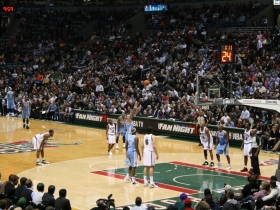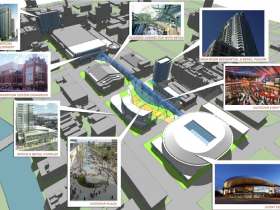Four Plans to Save the Bucks
But can any of the plans create the new NBA arena they need?

Chris Anderson of the Denver Nuggets shoots free throws against the Milwaukee Bucks. Photo taken on February 16th, 2011 by Jeramey Jannene.
The old adage about Milwaukee is that you can’t get people to come here and then you can’t get them to leave. Few want to move to what’s still seen nationally as a very unsexy city, but once they get here they fall in love with Milwaukee, cold weather and all.
Which still leaves the problem of how to get them here. One key way that businesses recruit top prospects is by selling them on the sports teams (Packers, Brewers, Bucks) and the arts scene (symphony, ballet, art museum). That would help explain why business leaders from Waukesha are pushing their politicians to support a tax to help pay for a new NBA arena, as Rich Kirchen and the Business Journal reported. This is one of at least four possible solutions to the problem. Do any have a chance of success? Let us consider the question.
A Regional Tax: The Metropolitan Milwaukee Association of Commerce has been trying to sell the idea of a four or five-county tax to pay not just for an new NBA arena, but for other county cultural and entertainment facilities, like the Milwaukee County Zoo, Milwaukee Public Museum and Marcus Center for the Performing Arts, that draw most of their audience from beyond Milwaukee County.
I have long felt a regional tax is needed for regional cultural attractions, but I don’t see this effort going anywhere. Republicans lost control of the state senate in the 1990s when GOP state senator George Petak was recalled from office for supporting a tax on constituents for Miller Park. Some Republicans felt the Democrats politically exploited the situation.
And that was back before this metro area became the most polarized community in the U.S., as Milwaukee Journal Sentinel reporter Craig Gilbert has amply documented. In short, this could be the one metro area in America that’s least likely to work together and where the two parties most distrust each other.
County boards in Waukesha, Ozaukee and Racine counties have already passed resolutions opposing any regional tax. Getting Racine to support the Bucks might be really tough, as 22 percent of the fans there actually support the Chicago Bulls, compared to 19 percent who support the Bucks. (See the map created by the New York Times.)
The odds are much better in Waukesha County (42% support the Bucks, 11% favor Bulls), Washington County (37% Bucks, 11% Bulls) and Ozaukee County (33% Bucks, 11% Bulls). By the way, at least 10 percent of fans in all three counties root for the Lakers. The horror.
Expand Convention Center in Conjunction with New Arena: My colleague Michael Horne has reported the details on this. This has one great attraction. The Wisconsin Center has taxing power and the legislature might be induced to “stick it to Milwaukee,” letting county residents (along with tourists to the city) shoulder the entire subsidy of a new arena by upping the current 2.5 percent Milwaukee County (hotel-motel) room tax, 7 percent room tax in the city, 0.5 percent countywide food and beverage tax and 3 percent county car rental tax.
But it would take one hell of a hike to pay for both a new arena and expanded convention center. And right now the Wisconsin Center and its U.S. Cellular Arena compete for bookings with the Bradley Center. Any merger here would have to include razing both arenas, which the Wisconsin Center board might oppose. And will the new owners of the Bucks want an arena controlled by a governmental entity? By contrast, the Bradley Center’s board is basically run by business leaders, who have required other tenants, like the Marquette Golden Eagles and Milwaukee Admirals, to subsidize the Bucks. The new owners will want the same sort of deal. I don’t see this plan happening.
A Super TIF: It’s big, it’s bold, it sounds like a character out of Marvel Comics. The ever-busy MMAC has also floated this super-sized solution. A TIF or tax incremental financing district has been used to support new development: the local government creates a TIF district, grabs all property taxes from the district to support the development and then repays the money from future tax revenues spun off by the development and surrounding TIF district. A Super TIF would add other taxes collected in the district, like the sales and income taxes, and make them part of the package.
Milwaukee Common Council President Michael Murphy requested a report on Super TIFs in Rochester MN and Allentown. The latter seemed the most relevant: its “Revitalize Downtown Allentown” plan covered a 130-acre area and included funds for a $177 million, 10,000-seat arena, as Kirchen and the Business Journal reported. This sweeping plan grabbed the state corporate income tax, state personal and local income tax, state sales tax and various other taxes.
Super TIFs have also been used — and have generated criticism — in Missouri.
The Super TIF has one huge advantage: its sheer complexity. As it is, no one understands a TIF and the super-sized version is even more complicated. It short, it could be the perfect stealth tax, that the legislature quietly passes into law — overnight — with no discussion.
But it looks like the legislature won’t go quietly on this one. Assembly Speaker Robin Vos (R-Burlington) has already expressed skepticism, noting that any income and sales taxes in the TIF district that didn’t go back to the state coffers, per usual, might leave other municipalities wondering why they couldn’t have the same opportunity.
A Privately Financed Mini-City Development: This has barely gotten any discussion, yet might be the most realistic. Some community leaders see the new arena as the centerpiece for a downtown entertainment district that could attract a new hotel, restaurants and bars, including some with a basketball theme. Then you add in the fact that new owners Marc Lasry and Wesley Edens are two of the wealthiest hedge fund plutocrats in America, and Edens has experience doing real estate projects.
“Edens and Lasry also have sent signals that they will entertain local investors both in the team and in an arena project,” writes JS reporter Don Walker. “That not only provides additional private capital, but gives credibility to the overall project. And Hammes Co., which is advising the MMAC arena committee, has had experience linking new arenas with new development.”
One huge advantage here is the developers would be painting on an empty canvas. The Bradley Center has been quietly buying up property around it, and now controls almost all of the land between N. 4th and 5th Sts., between W. Highland Blvd., and W. Juneau. There is also empty land in the adjoining Park East area. And the Park East land west of river is considerably cheaper. The city could perhaps pay for the land needed and create a traditional TIF, the sort it has done for other business developments.
Why would the owners basically pay for the development themselves? Well, they will get a $100 million subsidy from longtime owner Herb Kohl. Kohl, I suspect, will do everything to keep the team in Milwaukee. And there is an advantage to having total control of a business, rather than dealing with some board’s oversight, even one stacked with business leaders. There is also an advantage to moving quickly rather than waiting for the right tax subsidy, not getting it, and then moving to Seattle in 2017 (the deadline by which Milwaukee must have a new NBA arena) and starting the process all over.
All signs suggest the value of an NBA franchise will only continue to rise, as the sport becomes ever more popular internationally. Maybe a new arena actually makes more sense as a business proposition than as a charity.
More about the New Bucks Arena
- Murphy’s Law: Bucks Violating Promises on Unions? - Bruce Murphy - Jun 5th, 2025
- Back in the News: Bucks Owners Continue to Cash In - Bruce Murphy - Nov 28th, 2022
- Murphy’s Law: Bucks Subsidy An Issue in US Senate Race - Bruce Murphy - May 9th, 2022
- Murphy’s Law: Bucks Franchise Worth $1.86 Billion - Bruce Murphy - Jan 25th, 2021
- Op Ed: County Parks Lost Funding to Bucks Arena - Patricia Jursik - Jul 7th, 2020
- Eyes on Milwaukee: Fiserv Forum Workers to Get $15/Hour - Jeramey Jannene - Jan 29th, 2020
- Eyes on Milwaukee: Bucks Beat Hiring Targets on Fiserv Forum - Jeramey Jannene - Nov 20th, 2019
- Murphy’s Law: Taxpayers Make Bucks, Brewers Rich - Bruce Murphy - Apr 16th, 2019
- Eyes on Milwaukee: Bucks Unveil Master Plan for Park East - Jeramey Jannene - Mar 15th, 2019
- Eyes on Milwaukee: Bucks Plan Massive Arena Signs - Jeramey Jannene - Feb 12th, 2019
Read more about New Bucks Arena here
Political Contributions Tracker
Displaying political contributions between people mentioned in this story. Learn more.
Flynn's Force
-
Making Neighborhood Connections
 Jun 4th, 2013 by Mark Doremus
Jun 4th, 2013 by Mark Doremus
-
How Police Reach Out to Youth
 May 28th, 2013 by Mark Doremus
May 28th, 2013 by Mark Doremus
-
Many Youth Feel Harassed
 May 8th, 2013 by Mark Doremus
May 8th, 2013 by Mark Doremus
Murphy's Law
-
National Media Discovers Mayor Johnson
 Jul 16th, 2024 by Bruce Murphy
Jul 16th, 2024 by Bruce Murphy
-
Milwaukee Arts Groups in Big Trouble
 Jul 10th, 2024 by Bruce Murphy
Jul 10th, 2024 by Bruce Murphy
-
The Plague of Rising Health Care Costs
 Jul 8th, 2024 by Bruce Murphy
Jul 8th, 2024 by Bruce Murphy























Forget anything that involves state money, will not happen why then should the little old ladies in tennis shoes, the soccer moms have to pay out for a project that others will profit and they will never use?
What about people who don’t own a car or drive paying for highways and road construction? I don’t go to Bucks games, but I still want a new Bradley Center. It’s called investing in Milwaukee’s future.
WOW! Let’s see – regional transportation needs – MMAC = NO F*&^&%ing Way; Regional Transportation Authority – MMAC =NO F((&*U^&ing Way; and Regional Cooperation for _________(pick an issue) – MMAC = NO F(*&(^ing Way BUT wait a new arena for professional sports with luxury boxes for lobbyists and MMAC members …er wait let’s talk about regional cooperation! Hypocrisy though name is MMAC!! Link the new arena with a regional transportation authority that seriously looks at modern high speed transit to Chicago, Madison, and throughout the region and then we’ll talk. Say good bye to the Bucks and maybe Oprah will bring the Clippers here.
Wis Con Digest – when the Bucks leave town please provide a source for the lost income and sales tax revenue derived from the Bradley Center. Looks like Milwaukee will be given the opportunity in the words of Tommy Thompson to “stick it to” the rest of the state.
It’s not just the Bucks who use the Bradley Center or the new arena – we all do and we as a community benefit from having a first class facility. 30 years ago, downtown Milwaukee and the area surrounding the arena was a dump. Look at the area now – Brewer’s Hill redeveloped. Schlitz Park – redeveloped; Pabst – redeveloped; Beerline – redeveloped; Third Ward – redeveloped; Fifth Ward – redeveloped. Don’t invest or don’t have a drawing card to bring people back into the city and that entire tax base is lost.
So Conservative Digest – pray for the Bucks to leave town so that we can Stick It to the rest of the state.
Let’s see. No Square D, Sealtest, American Motors, WA Krueger, Schlitz, Glen Rock Soda, Gallun, Bucyrus Erie , AC Delco/Delphi, A.O. Smith, Allis-Chalmers, Pabst, Cuneo Press, Cutler-Hammer, etc.. Has anyone considered maybe we are Omaha? Putting the Wisconsin Center out of its misery isn’t a bad idea however.
Sorry but this really pulls my chain!! What’s so incredible about this is how class, yes class based the idea of regional cooperation by the MMAC. I guess one shouldn’t be surprised but do any of the leaders of this group ever read anything about growing “modern” cities and regions? The idea that it is the arts, culture, and sports which draw young people and new businesses misses a whole arena (pardon the pun) of things for which young entrepreneurs are looking. This age group is drawn to places with modern transportation systems (notice i am not using that four letter word “light rail”, “trolley”, or “high speed rail”). And I know that none of them have ever attended a St. Louis Cardinals or New York Yankees or Chicago Cubs game and ridden the transportation systems that serve those places! Of course, basketball fans and convention goers and art patrons are of a different genre and would never do so! It’s time to play hard ball (ok another pun sue me) and get something for Milwaukee common folk in return for the MMAC coming down from the mountain top to offer us the golden calf of regional cooperation.
Ask Robin Vos about TIFs down in Burlington. I understand that his father Tom sits on the city council, and, that a TIF benefited Robin’s investment in a hotel or some such thing down there. How about THOSE TIFs paid for by taxpayers but benefiting legislators? How about that Robin???
“Let’s see. No Square D, Sealtest, American Motors, WA Krueger, Schlitz, Glen Rock Soda, Gallun, Bucyrus Erie , AC Delco/Delphi, A.O. Smith, Allis-Chalmers, Pabst, Cuneo Press, Cutler-Hammer, etc.. Has anyone considered maybe we are Omaha? Putting the Wisconsin Center out of its misery isn’t a bad idea however.”
What a bizarre comment. Milwaukee lost some industries and others were bought out/merged. What’s your point? Bucyrus is still here. It’s called Caterpillar. Cutler-Hammer is still here. It’s called Eaton. A.O. Smith. Still here.
I have enjoyed professional, college, youth, and municipal sports viewing and participation, and benefited from it throughout my life in Milwaukee. I also enjoy driving around on streets without pot holes, great educational institutions, cooperation in government that actually arrives at fair solutions that solves community problems that serves the interests and needs of the citizens that live here. Politicians outside Milwaukee actually snub their nose at us and heap on dirt any chance they can get.
While I personally feel professional and even college sports is put way too high on a pedestal, I do recognize the positives it can bring to a community at large and even on the state level.
The Bucks have been a bottom dweller for so long it is no wonder that only 19% in Racine are fans. A semblance of winning and sniff of 1st place may win over more fans and create some excitement just as the Brewers have been able to do with new ownership. The Packers have been able to excite for the last 23 years.
More than half the families of Milwaukee will rarely if ever be able to afford attending a Bucks game and gaining support from these struggling families is a very tough sell. They also lack a real strong political voice with people outside Milwaukee. How come we have not heard of a tax on ticket sales and luxury boxes to pay for an arena? Perhaps the NBA league does not allow it.
I don’t understand the point you’re making commenter. All those companies either went out of business or where merged with other companies. None of these companies moved from Milwaukee. Cutler Hammer is still here, it’s now part of the Eaton Corporation, I worked there. Bucyrus Erie is still here, it’s called Catepillar. Pabst and Schlitz beer is made here under Miller Brewing.
Can we knock it off with this suggestion that George Petak suffered some sort of outrageous blow when he lost his seat in whatever two bit branch of government he was elected to serve sometime in the 90’s. Am I to understand he lost his health insurance, got addicted to crack, gambled away his pension and now sweeps floors at the Mission by day so he can sleep there at night.
George Petak’s obituary is going to rightfully say that he was a brave person who put his chickenshit legislative job on the line to support the building of Miller Park. As a result, Milwaukee has a major league baseball team and a stadium worthy of it. It is a town recognized as a baseball town, and 2 million people go to its games every year.
Without George Petak, none of that happens. Every day of his life, whether he is with the grandkids or the boys at the bar, everyone will know he saved the Brewers. Your kid’s will read about him. That is the kind of reward we all shoot for, and he earned it. Don’t cry for George Petak.
Remember who replaced him? Who cares. I remember who replaced him. I remember that she replaced the good guy, and that is all I remember. She is the villain. Congratulations to her. And to hell with the next one who emulates her.
Thanks Matt for the perspective.
I celebrated the opening of the new stadium and I had a package of season tickets for a number of years. I was also struck at the same time at the price we pay to build a new stadium, but allow veterans buildings nearby to crumble and rot, dis-invest in education, allow infrastructure to crumble more each year, cut back on youth programs of music, arts, physical education and science, etc.
I have enjoyed sports my entire life as a participant and observer. We do need to balance out the costs and discuss fairness on who pays for what. And what has a higher priority? The majority of people in Milwaukee will rarely if ever attend a Bucks game and cannot afford it. I do hope a plan can raise concern for other issues and not just worship the sports gods.
@Greg All those companies employed tens, if not hundreds of thousands of middle class jobs. They are gone and those that are left employ a fraction of what they once did. I’m saying we no longer have a tax base to purchase whatever Franklyn Gimbel is selling this week. The Milwaukee Theater is a money pit that will never earn back the $41.9 million it cost to convert the Auditorium.
The Menomonee Valley held 50,000 heavy manufacturing jobs at one time. Today it is at around 7,000. Many thousands more were lost in the Metro area. During this last major downturn, two car companies closed shop in southeast Wisconsin along with at least three paper mills in the Fox Valley. These are permanent losses and have not been replaced by other production positions.
Detroit lost over 300,000 auto manufacturing jobs during the last three decades. That is why they have downsized and are in a tough position economically. Wal-Mart and McDonald’s jobs do not support the wages and purchasing power that the manufacturing positions hold.
I performed an analysis about 15 years ago from census data. During the late 1900s, the Milwaukee Metropolitan area reduced inflation adjusted overall median family income from about $9 Billion to $7 Billion per year (1980 to 2000). I have not replicated this for 2010, but it would be an interesting piece of information to investigate.
What does Milwaukee Long-Range Comprehensive Plan say? Is there a plan for they current Bradley Center or investment in a new facility? Where are the city’s Urban Planners in all this… have they been consulted or is there a jump directly to the politicians?